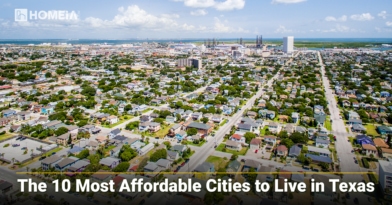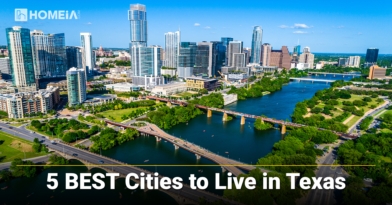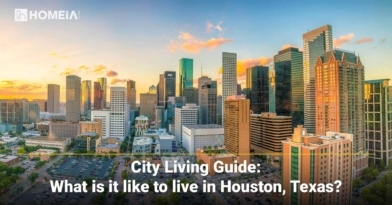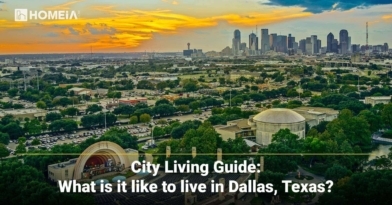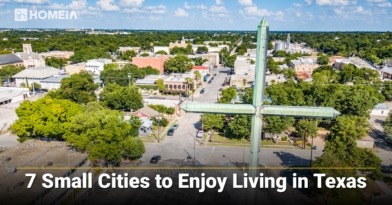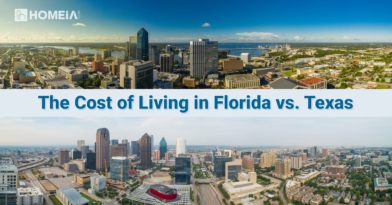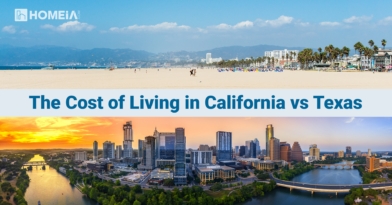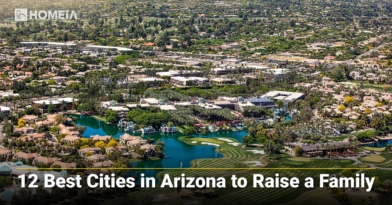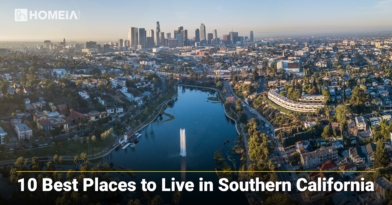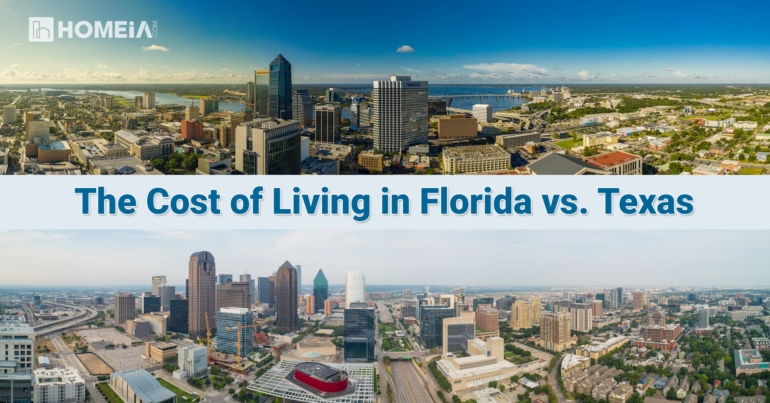7 Best Places to Live in San Antonio for Families
- Author:by The HOMEiA Team
- Category: City Living Guide

More than 2 million people call the San Antonio metro area home, and the population is projected to double by 2050. Young professionals, families and retirees flock to the city, drawn by the absence of a state income tax and by its diversified economy, rich cultural traditions and gorgeous green spaces.
Though San Antonio isn’t the only place in the Lone Star State that is experiencing rapid growth, the city stands out with Texas’s highest percentage increase in jobs offering six-figure salaries.
And though it is the seventh-largest city in the United States, San Antonio is a sprawling metropolis that still offers spacious lots, Hill Country views and distinct neighborhoods with small-town Texas vibes, all in contrast with a vibrant and bustling downtown.
Though the temperature is known to reach 90 to 100 degrees Fahrenheit in the summer, San Antonians beat the heat with easy access to natural springs, rivers and lakes. The city also boasts the most tree canopy coverage of any major U.S. city, with 38% of the city under tree shade.
It’s a city as geographically diverse as it is culturally diverse, and one where residents can just as easily marvel at skyscrapers as white-tailed deer from their front porch. All this comes with a cost of living below the national average.
If you are planning to relocate to San Antonio, there are more than 30 distinct neighborhoods to consider in this area of real estate in Texas. Whether you want the big-city amenities afforded by a loft downtown or prefer to kick back under the shade of a Texas red oak while you watch the San Antonio River ramble by, there are plenty of options.
To help you navigate all that San Antonio has to offer, we’ve narrowed it down to the 7 best neighborhoods and ranked them by affordability.
Table of Contents:
1. Oak Meadow
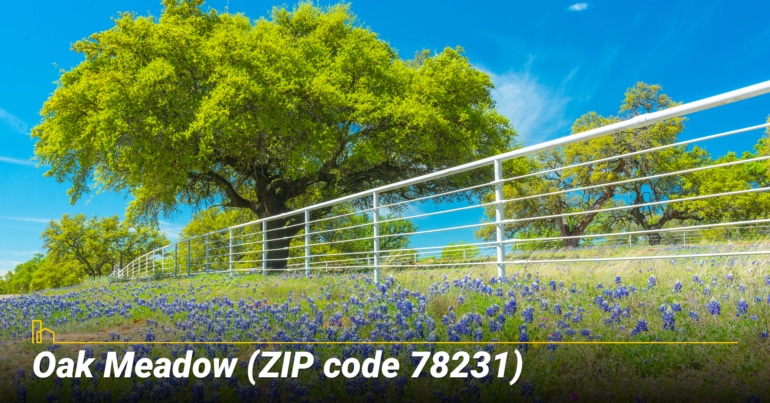
The Oak Meadow neighborhood is composed of mainly single-family homes with two to four bedrooms; built in the 1970s, ’80s and ’90s; with some apartment complexes and high rises spread throughout the area. The neighborhood has a suburban feel. Oak Meadow residents enjoy easy access to Eisenhower Park and Hardberger Park, as well as several notable local restaurants such as El Mirasol, Pasha and Two Bros BBQ. The neighborhood is known for a concentration of residents with German, Austrian and Eastern European roots.
The median home sale price is $418,132, and the average rent paid in the area is $1,571. Rent in this neighborhood is in the lowest 45% of the state of Texas, while home prices are more expensive than 78% of those in Texas.
The neighborhood is 90% occupied, which is about average nationally. It won’t be easy to find a home for sale or an apartment for rent in Oak Meadow (as of May 2022), but it isn’t any more difficult than in most other neighborhoods. You can anticipate waiting lists for vacancies at most apartment complexes.
Oak Meadow residents generally commute to their jobs, averaging 15 to 30 minutes of travel per day, which is lower than the national average. The most common mode of transportation is personal vehicle. The most common types of employment in the area are in managerial and executive-level professions, and the median household income is $68,696, which is 24% higher than the national average.
The 10 Cheapest Places to Live in Texas
They say everything is bigger in Texas, and for good reason. From some of America’s largest and active metropolitan cities to the host of recreational activities for people of all ages across the state to the many bigger-than-life personalities who call Texas home, Texas has plenty to offer for everyone. here’s the list of 10 lowest cost of living places…
The second most common type of employment for Oak Meadow residents is the sales and service sector, which makes up 19.9% of the neighborhood’s employment pie. The unemployment rate in Oak Meadow is 3.6%, which is below the national average.
Violent crime in Oak Meadow is 57% lower than the national average, though property crime is 63% higher. The neighborhood is one of the safer areas in San Antonio, with yearly crime on the decline. Statistically, you have a 1 in 30 chance of falling victim to any crime in Oak Meadow, making it safer than 64% of all Texas cities.
There are several family physicians located within the Oak Meadow neighborhood, and nearby hospitals include University Hospital, North Central Baptist Hospital and Northeast Baptist Hospital.
School-aged children in the neighborhood may attend one of four public elementary schools (Blattman, Oak Meadow, Huebner and Larkspur), one of two middle schools (Jackson and Eisenhower), and Churchill High School. These schools are part of the Northside ISD, which serves 107,817 students and has a 15:1 student-to-teacher ratio for the 2020-2021 school year. Of all students, 9.9% are enrolled in bilingual or ESL learning programs. The high school graduation rate for the district is 94.4%.
Recommended for you
2. Stone Oak

Stone Oak is one of the largest neighborhoods in San Antonio. It is located in the northern sector of the city and comprises more than two dozen individual subdivisions. Homes in this area are newer than in many neighborhoods in San Antonio, with the average home built in the 1990s.
There are also several apartment complexes within the neighborhood.
Stone Oak is economically diverse, with modest single-family homes listing in the $200,000s as well as luxury houses within gated communities like The Forest and The Heights that sell for more than $1 million.
The median home sale price in the neighborhood is $461,000, and rent for two-bedroom apartments in the neighborhood ranges from $1,350 to $2,850. The area is primarily (about 65%) owner-occupied homes.
The neighborhood has more than 30 acres of greenbelt and a community pool, and it is home to the Canyon Springs Golf Club, which has been featured in Golf Digest Magazine.
The vibe of the community is less “big city” than other areas in San Antonio, and homes are situated on larger lots with an emphasis on green space.
5 Best Places to Live in Texas
Each of the five large cities described are chock-full of neighborhoods that are favored by families with children, young professionals, and retirees. We’ll focus on eight critical attributes that often define a city: History and population, Lifestyle, Affordability, Housing market and neighborhoods, Healthcare and safety, Employment…
Stone Oak is near Chester’s Hamburgers, Schakolad Chocolate Factory and Orange Leaf Frozen Yogurt for dining out. It has a Sprouts Farmers Market, Trader Joe’s and HEB for grocery shopping. The neighborhood is very walkable and bikeable and also has two electric vehicle charging stations.
The median household income for Stone Oak residents is $103,908, twice that of the average San Antonian. The unemployment rate in the area is low, at 2.9%. The top employment careers for Stone Oak residents are executive positions and education or healthcare jobs.
Stone Oak is considered safer than 78% of neighborhoods in the U.S. Less than 1 in 1,000 residents will experience a violent crime in Stone Oak.
Stone Oak has several hospitals and clinics located within or very near the neighborhood, including Methodist Hospital Stone Oak, the Children’s Hospital of San Antonio and the Stone Oak Clinic. Access to healthcare in the neighborhood can be considered excellent, and these facilities also serve as top employers for those who live in Stone Oak.
Stone Oak is served by the North East ISD, and about 36% of the households in Stone Oak have kids. The area is considered to have excellent schools, with numerous options in both the public and private school arenas. Area schooling standouts include Bush Middle School (ranked #2 in the city), Hardy Oak Elementary School (ranked #4 in the city), the International School of the Americas (ranked #3 in the city) and Reagan High School (ranked #2 in the city).
Recommended for you
3. Tobin Hill
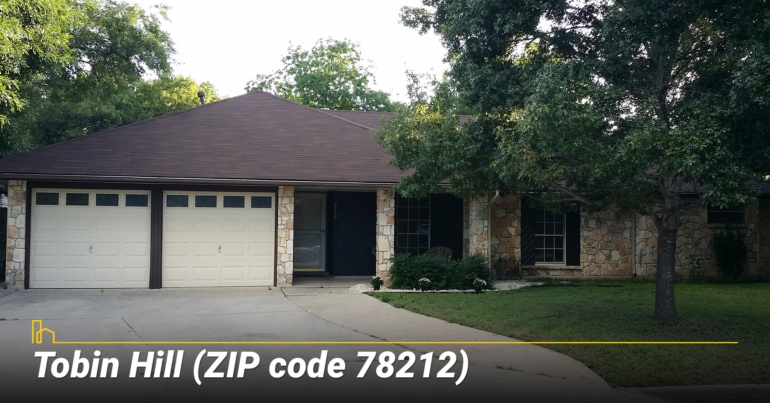
Tobin Hill is most known for the trendy Pearl Brewery Complex. It stands out from other San Antonio neighborhoods because the majority of Tobin Hill residents are renters – about 89% of them. The homes in the area are situated just north of San Antonio’s downtown and the neighborhood is one of the oldest in San Antonio. Rental properties here are largely subdivided buildings consisting of smaller studios and apartments. It is also the third-most-walkable neighborhood in San Antonio.
Homes in this area are a mix of styles, including Victorian, Craftsman, bungalow and four-square. In terms of employment, there are more “professionals” in Tobin Hill than any other demographic, and more people live alone in Tobin Hill (54.3%) than in other parts of San Antonio.
The average Tobin Hill resident lives within a five-minute stroll from a coffee shop, bar or restaurant, making it one of the most walkable areas in the city. The neighborhood roadways feature bike lanes, and nine bus lines run through the area, making it one of the most public-transportation-friendly places in San Antonio.
There are four electric vehicle charging stations located throughout Tobin Hill.
15 Best Cities for Families in Texas
There are many employment opportunities throughout the state and many enjoyable communities to call home. We’ve compiled a list of 15 cities that rank high in education, affordability, and safety—areas of interest for many potential homeowners…
Apartments and houses provide a mix of rental arrangements in the area, with costs ranging from $331 per month for a small studio to $7,682 per month for a luxury one-bedroom.
The median sale price for a house in Tobin Hill is $466,000.
The median household income in Tobin Hill is $55,114, and the area is noted to be ethnically and economically diverse. The military is a notable employer for Tobin Hill residents, and many others are employed in professional occupations (56.8%), service and sales (24.1%) and manufacturing (12.7%).
Noise and crime issues have arisen in the area, likely owing to the increasing popularity of nightlife in the neighborhood. It is still considered safer than 27% of Texas cities and is a neighborhood perfectly suited to students, singles and young professionals who want access to downtown-like amenities.
The neighborhood hosts a farmers market, and residents enjoy cultural activities such as attending shows at the Tobin Center for the Performing Arts or taking walks through the Japanese Tea Gardens.
Healthcare access for Tobin Hill residents is good, with numerous local clinics and Metropolitan Methodist Hospital located within the neighborhood.
With only 12% of households in the area having children, it is not surprising that schools in the neighborhood are not top ranking. Most notable are Travis Early College School (ranked #27 in the city) and the Young Women’s Leadership Academy (ranked #15 in the city). Most schools in the area are rated in the B to C range.
Recommended for you
4. Alamo Heights
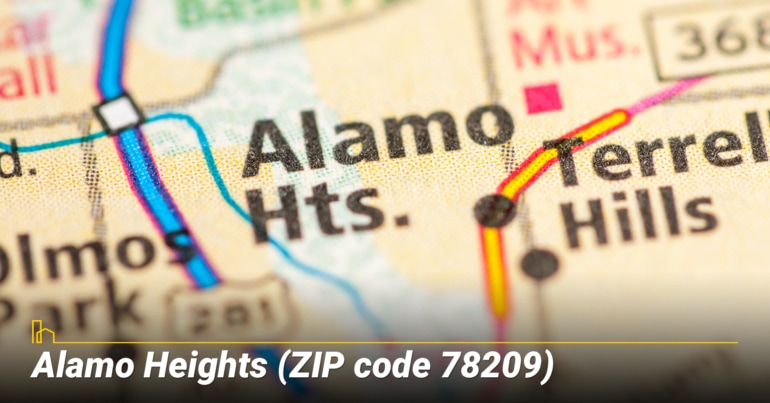
Located near Fort Sam Houston, Alamo Heights is a historic neighborhood with many restaurants, parks and bars. A majority of its houses were built in the 1950s or earlier. Alamo Heights is an incorporated city with a population of 8,370 that is surrounded by San Antonio and considered part of the greater San Antonio metropolitan area.
About 69.8% of the homes in Alamo Heights are owner-occupied. The median sales price of homes in Alamo Heights is $627,500, with a competitive sales market compared to the national average (as of May 2022). The average monthly rent in Alamo Heights is $1,439, higher than the national average.
There are many retirees in the neighborhood, though the area is family friendly as well, with some top-rated schools.
The median household income for Alamo Heights is $155,983, and 54.1% of residents have a bachelor’s degree, making it one of the most educated neighborhoods in San Antonio.
Most households in Alamo Heights own two cars, and the average resident makes a 16-minute commute to their place of employment. The largest employment sectors for Alamo Heights residents are healthcare and social services, scientific and technical jobs, and education.
12 Key Factors to Know About Living in Houston
Houston, Texas is a vibrant city with much to offer. U.S. News & World Report ranks Houston #30 in its Best Places to Live assessment and #26 in Best Places to Retire. There’s much to love about this southern city, nicknamed Space City in the days of the NASA Manned Spacecraft Center…
Violent crime is 82% below the national average in Alamo Heights, and property crime is 12% higher. Your chances of falling victim to any crime in Alamo Heights are 1 in 45, though crime rates in the area are on an upward trajectory. Over the last year, crime rates have risen 22% in the area, though it is still considered safer than 49% of other U.S. cities.
Alamo Heights is home to many primary care medical practices as well as CHRISTUS Santa Rosa Hospital, making healthcare very accessible to residents of this neighborhood.
Children in Alamo Heights are served by the Alamo Heights ISD, a top-rated district in San Antonio. State test scores rate 61% of students as proficient in math and 63% as proficient in reading. The average high school graduation rate in the district is high, at 97%, and the student-to-teacher ratio in the district is 14:1, better than the national average of 17:1.
Recommended for you
5. Monte Vista
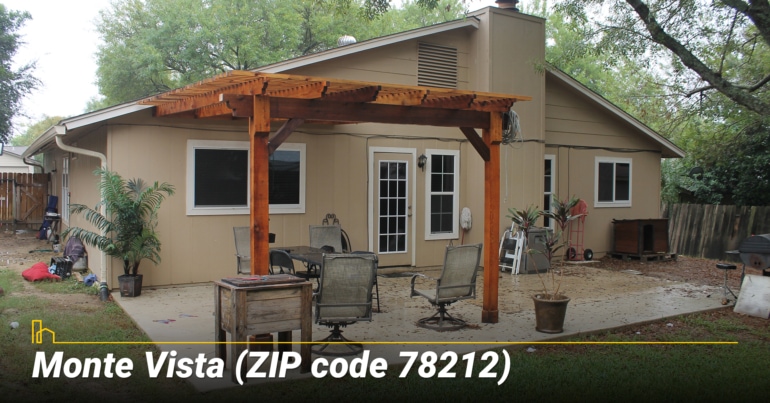
The Monte Vista neighborhood is popular with young professionals and singles, with a mix of sprawling estates, apartments, condos and historic homes that are primarily used as single-family dwellings. The Monte Vista Historical Association is active in the community, with monthly meetings and family-friendly planned activities throughout the year.
The neighborhood is located just 1.5 miles north of Downtown San Antonio and is made up of 14 subdivisions along 100 city blocks. About 54% of Monte Vista residents rent their property, with the average rent for a one-bedroom apartment in Monte Vista at about $1,150, which is a 41% increase from 2021.
Just 10% of the neighborhood’s households have children. The median age of Monte Vista residents is low, at 31, and the median household income is high, at $105,774. The median home sale price in Monte Vista is $714,000.
Many Monte Vista residents are employed as professionals or within the education and healthcare fields. In this neighborhood, male median earnings are 41% higher than female median earnings.
What is It Like Living in Dallas Texas?
The city is the 9th largest in the United States. Dallas Texas is a little bit country, a little bit rock ’n’ roll, and a whole lot of history, arts, culture and business in the center of the fourth-largest metropolitan statistical area in the United…
Crime is 155% higher than the national average in Monte Vista, higher than in other areas of San Antonio, with your chances of falling victim to any crime 1 in 17. It is important to note that most of the crime in the area is classified as petty burglary or nuisance/noise due in part to the younger population and the busy nightlife in and around the area.
Monte Vista residents will generally need to travel outside of the neighborhood to access healthcare, though a few clinics do exist within the bounds of Monte Vista.
Though the area does not primarily cater to families, eight schools serve the neighborhood, ranking moderately within the San Antonio ISD. The Monte Vista Montessori School and Great Hearts Monte Vista Charter School are also located within the neighborhood.
6. Downtown
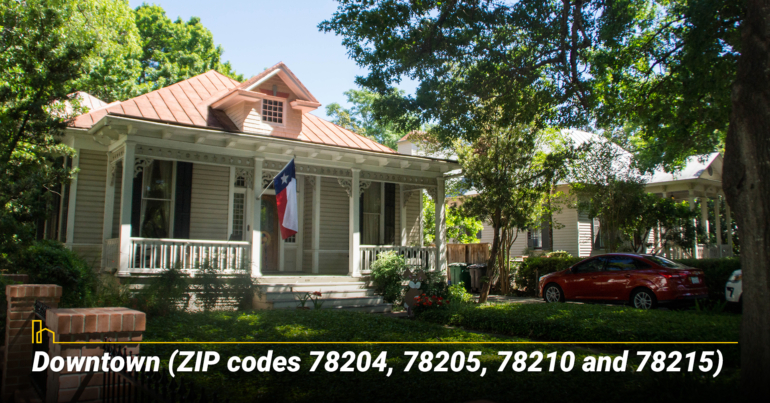
Downtown San Antonio offers a wide variety of housing types, with many buildings and homes dating earlier than 1939. Of households in the downtown area about 38% are owner-occupied, making renters the primary occupants of the neighborhood.
The median home sale price in downtown San Antonio is $670,000, and rental rates vary from modest one-bedroom apartments starting around $1,521 to luxury apartments along the River Walk starting at $2,800. The residents downtown are largely young professionals, many of whom have attained some college, and 41% of whom have never been married. There are slightly more men than women living in downtown San Antonio: The residential population is about 53% male and 47% female.
Most downtown residents work white-collar jobs (72.17%), primarily for private companies. There are also many government-employed (13.95%) and self-employed (8.11%) workers in the neighborhood.
Crime in downtown San Antonio is on the decline, down 13% in the last year. Overall crime rates are still higher than the national average, but it is not the most unsafe area of San Antonio. Your chances of falling victim to any crime in downtown San Antonio are 1 in 30.
Downtown San Antonio is a medical hub, with 10 nearby hospitals as well as the U.T. Health Downtown Campus. Access to healthcare for residents is thus very good.
School-aged children who live in downtown San Antonio are served by the moderately ranked San Antonio ISD, as well as a mix of private and charter schools.
7 Best Small Towns to Live in Texas
We present 7 smaller cities that are great for professionals, retirees, and families with children. Incidentally, they also happen to be places that I have enjoyed visiting with family and friends over the decades. In our examination, we’ll prioritize things that may be more important for families who prefer not to live in heavily urbanized areas…
7. Terrell Hills

In the affluent neighborhood of Terrell Hills, the homeownership rate is 90.4%. The area is among the most expensive real estate markets in Texas. Terrell Hills is actually an independent municipality with its own city council, mayor and police department.
Terrell Hills has a population of 5,534 people and is located about five miles north of downtown San Antonio. Thirty-one percent of homes are valued above $1 million, the majority of those being single-family dwellings. The majority of homes in the neighborhood were built between 1940 and 1960, though 17.7% are older.
There is a small portion of renters in the neighborhood, living in a mix of townhomes and apartment residences. These rentals come at a premium price, with a 905 square-foot unit starting at $1,439.
The Cost of Living in Florida vs. Texas
Texas and Florida are vast and have hundreds of communities to choose from. But what are the pros and cons of living in each state? Come with HOMEiA as we explore 7 crucial factors that reveal the true costs of choosing Florida or Texas as your new home…
Terrell Hills residents are primarily white-collar workers (95.4%) with college degrees. A higher-than-average percent of residents telecommute (14.77%). The professionals in the area are primarily employed in management, sales and knowledge-based fields such as technology, earning a median income of $181,979.
For that premium price, Terrell Hill residents live in relative safety. The chances that you will become a victim of any crime in Terrell Hills is 1 in 499 in the northeastern neighborhoods and 1 in 844 to the west side. Bel Meade Homes is considered the safest area of Terrell Hills, followed by City Center.
Though there are urgent care and small clinics in Terrell Hills, residents requiring medical care may need to travel outside of the neighborhood to receive it. This is likely not a problem for residents, 97.1% of whom are covered by health insurance.
Families with children in the area are served by highly ranked Alamo Heights ISD schools. Nearby postsecondary schools include the Culinary Institute of America, Trinity University and the University of the Incarnate Word.
Terrell Hills is consistently one of the hottest real estate markets in San Antonio, combining safety, exclusivity and proximity to downtown culture. Residents can easily get to Central Market, the Pearl Brewery Complex, the San Antonio Botanical Gardens, the McNay Art Museum, the Witt Museum and the San Antonio Zoo.
Terrell Hills is one of the best places to live in San Antonio, though the safety and amenities come at a premium price.
The Cost of Living in California vs Texas in 2023
Both California and Texas have not only the largest populations but the largest habitable landmass of any of the U.S. states. This means there are not a lot of statements that can be made which represent either state in totality. We’ll let you know here the general cost factors to consider when making a decision to relocate to either state…
Frequently Asked Questions
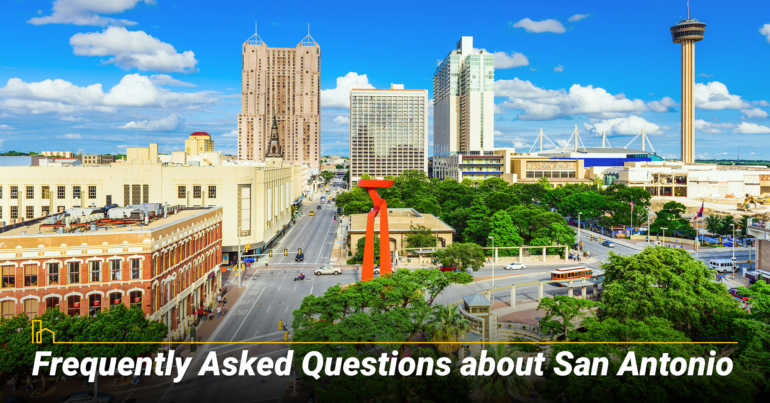
1. Is San Antonio a sports town?
San Antonio has one top-level professional team in the NBA’s San Antonio Spurs. It also has minor league teams, including the San Antonio Missions (baseball) and the San Antonio FC (soccer).
There is also an abundance of local college-level sporting events; San Antonians can cheer on the UTSA Roadrunners in a variety of sports.
Geographically, San Antonio is centrally positioned between three other major cities, so traveling to see major sports teams in Dallas (275 miles), Austin (80 miles) or Houston (197 miles) is always an option.
2. What is the local food scene like?
Nothing compares to the local favorite, “barbacoa and Big Red.” It’s a regional paring that is even celebrated with an annual festival.
Barbacoa is a particular type of seasoned, shredded beef, served taco-style in a tortilla. (When asked your preference of flour or corn, note that corn is the traditional option.) It is usually topped with diced white onion, cilantro, salsa and a squeeze of lime.
No barbacoa meal is complete without an ice-cold Bid Red soda, a red-colored cream soda (sold by PepsiCo) that originated in Waco, Texas. The red-colored soda is flavored with lemon, orange and vanilla notes, and it was predominately available in south and central Texas until the late 1970s.
Aside from the barbacoa, San Antonians rave about their local breakfast tacos and anything sold by Texas grocer HEB.
Pros and Cons of Living in Florida
If you’ve decided to make Florida your new home, you’re in luck – it’s a big and varied place, with something for all ages, family dynamics and budget. Continue reading as we dive into some notable Pros and Cons about the state itself, the top cities to live in across a variety of categories, and…
3. How are the margaritas?
As in any large Texas city, San Antonio is teeming with clubs and bars serving their signature margaritas. Rocks or frozen cocktails are typically prepared with fresh lime, agave syrup and a Texas-made tequila. San Antonians take their margaritas very seriously.
There is a dizzying list of “best margaritas” within the city, and thanks to one lasting vestige of the COVID-19 pandemic, restaurants and bars are now able to sell them to go (along with a food sale).
Liquor laws in Texas are a little stricter than in other areas of the U.S., so newcomers should note that while beer and wine are sold at local grocery stores, gas stations and convenience shops, liquor can only be procured in a dedicated liquor store.
There are also rules about hours of purchase, which were recently expanded throughout the state. You have from 10 a.m. until 9 p.m. to purchase liquor, except on Sundays and some holidays, when liquor stores are closed. Beer and wine sales fall under a different and more generous set of availability rules, as do on-premises bar and restaurant sales.
4. Is San Antonio a concrete jungle like other big cities?
No! The seventh-largest city in the U.S. is also brimming with outdoor recreation. Eighty-two square miles of improved greenway trails make for easily accessible hiking and biking.
San Antonio is also one of the most walkable cities in the U.S., ranking #37 nationally, with downtown, Five Points and Arsenal considered to be the most walkable neighborhoods.
The San Antonio River cuts through the city, forming the vein of a scenic shopping and dining center known as the San Antonio River Walk. The attraction is complete with pedestrian bridges and rentable gondolas. Most restaurants in the area have outdoor patio seating for tourists and locals to soak up the sunshine while they dine.
San Antonio is also flanked by 13 state parks and numerous rivers, natural springs and lakes.
In the spring (late March to early April) San Antonians flock to roadsides and fields to take photos with the abundant and iconic flowers known as Texas bluebonnets. Whether the photos feature whole families, kids or pets, a springtime bluebonnet photo session is a Texas tradition observed in San Antonio.
The 10 Most Affordable Places to Live in California in 2024
We assessed the cost of living across Californian cities and compared them to the national average. The cost of living is calculated based on 5 main categories: housing, food, healthcare, transportation and energy. Based on these calculations, we narrowed down the list to California’s 10 most affordable cities…
5. How are the traffic and road conditions?
As in most big cities, San Antonians can expect heavy traffic during the morning and afternoon rush hours. The regional traffic ranks fifth worst in the state of Texas, so San Antonio is slightly less congested than Houston, Dallas and Austin. With the current influx of residents to the city, traffic conditions are expected to worsen as time goes on.
This year, San Antonio commuters will lose an average of 23 hours to traffic and 70 hours to rush hour, according to Global Traffic Scorecard. Road conditions in San Antonio are also a contributing factor to traffic, as San Antonio is among the 25 worst cities for road conditions in America.
The problem is exacerbated by subpar public transportation for a city of its size. Compared to other major U.S. or Texas cities, San Antonio lags in efficient bus systems and bike-friendly lanes on public roads. Still, there is a bus system, and the $1.30 regular bus fare is affordable compared to other cities.
Newcomers to Texas quickly learn about “feeder” or “access” roads when they come to San Antonio. These are one-way roads that run alongside the highways. Whether exiting or entering a highway, the interchange typically begins and ends on an access road. Since these roads travel in only one direction, drivers will often have to go past their intended destination and make a U-turn if their destination is on the left side of the freeway.
6. Is it unbearably hot?
San Antonio is located in central Texas, where summertime temperatures can reach the mid-90s and low 100s with regularity. Still, with the abundant access to water in the area, locals would not consider the city to be unbearable.
San Antonio is also exceptionally shady, ranking as having the largest tree canopy coverage among any large U.S. city at 38%.
San Antonians can expect to wear shorts and t-shirts well into the Thanksgiving holiday season, on average.
12 Best Cities to Live in Arizona for Families
We took 4 main variables into consideration to determine the best places in Arizona to raise a family. The variables are quality of education, health care, personal safety, and recreational opportunities. Here you’ll find our list, along with the highlights that make each Arizona locale a special place to raise a family…
6. Is it pet-friendly?
Yes! San Antonio has followed national trends that lean toward pet-friendly public spaces. The city has numerous public and private dog parks, and most outdoor shopping areas and restaurants with outdoor patios allow well-behaved leashed pets. The entire San Antonio River Walk is pet friendly as well.
Renters will not have difficulties finding apartments and homes that allow pets, though pet rent fees and deposits are standard.
Backyard chicken owners can rejoice: Many areas of the city also allow domestic fowl and livestock, with certain limitations surrounding the number of animals and the location of their quarters. Unlike many cities, San Antonio even allows those who meet the criteria for backyard chickens to keep one rooster.
7. Are there community festivals and events?
San Antonians love to gather and celebrate. New Year’s Eve and Independence Day usher in huge public and private fireworks displays around the city, with law enforcement typically turning a blind eye to fireworks set off within neighborhoods (technically not permitted).
The largest annual festival in San Antonio is known as “Fiesta,” and it commemorates the Battle of the Alamo — also known as the Battle of the Flowers. Fiesta spans 11 days, from March 31 to April 10, and schools and employers let out early during the festivities. Three parades operate around the city, including an iconic river float parade. This single event draws $340 million in revenue and raises funds for local nonprofit organizations.
10 Best Places to Live in Southern California in 2024
HOMEiA is here to help you explore ten of the best places to live in Southern California. Each place has its own charm and unique qualities. Let’s take a quick dive into what Southern California has to offer! Here’re 10 best places to live in Southern California…
